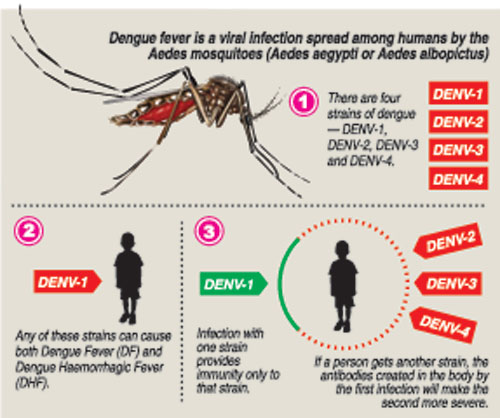News
Vitamin E cuts virulence of dengue
Reduces duration of leaking in DHF
Anti-oxidants in the vitamin useful in management of DF & DHF
Proven through a Clinical Trial at LRH
With the monsoon winds lashing the country bringing about heavy showers and also dry spells on and off, the spectre of dengue rises once again.

Pic of Prof. Pujitha Wickramasinghe
Terrified are the people, especially parents with young children, fearful of the disastrous consequences of this mosquito-borne viral disease.
Amidst the gloom and the doom, there is good news.
The use of Vitamin E during a dengue infection, be it Dengue Fever (DF) or Dengue Haemorrhagic Fever (DHF) helps to reduce the virulence of the infection, a groundbreaking study has revealed.
Vitamin E ‘significantly’ reduced the duration of leaking, the major culprit for complications in DHF, the Sunday Times learns.
Reiterating that Vitamin E should be used in the ‘management’ of dengue along with the usual treatment protocols, Honorary Consultant Paediatrician, Lady Ridgeway Hospital (LRH) for Children, Prof. Pujitha Wickramasinghe who is also Professor in Paediatrics at the Faculty of Medicine, University of Colombo was categorical that “it is not a cure by itself”.
“We have known the usefulness of Vitamin E through clinical experience but now it is scientifically established,” he says, adding that the purpose of the study was to determine whether the anti-oxidant properties of Vitamin E would be helpful in the management of DF and DHF in children.
The ‘significant’ results of this study — a Clinical Trial (CT) conducted among 127 children in the age-group 5-12 years at the LRH who fulfilled the clinical criteria for dengue infection — have been published in October in the respected indexed Asian Pacific Journal of Tropical Medicine under the title ‘Effects of Vitamin E supplementation on the clinical outcome of DF and DHF in children’.
The objective of this ‘triple blinded controlled interventional trial’ was the evaluation of the effects of Vitamin E supplementation on the clinical course of DF and DHF.
Ethical clearance had been obtained as also approval by the National Medicines Regulatory Authority, with the protocol being registered in the Sri Lanka Clinical Trials Registry. Informed written consent had been obtained from the parents and the participants.
A CT means a carefully and ethically-designed experiment, in which the participants are assigned to different modes of intervention simultaneously at random. They are also supervised in a simultaneous way. Meanwhile, ‘triple blind’ denotes that the participant, the observer-researcher and the statistician who analyses the data do not know who receives what treatment – the Vitamin supplementation or the placebo (a fake treatment which has no adverse effect).
Detailing the study, he conducted along with Dr. P.W. Prasad Chathurangana at the LRH’s Professorial Paediatric Unit, from August 2015 to July 2016, Prof. Wickramasinghe says that children recruited for it fulfilled the clinical criteria for dengue infection.
These criteria were fever and two other clinical symptoms such as headache; retro-orbital pain (pain behind the eyes); myalgia (muscle pain); arthralgia (joint pain), bone pain and haemorrhagic manifestations (bleeding). These children had been admitted to the LRH within the first 84 hours of the onset of fever. Any child with an underlying chronic illness such as cardiac (heart), renal (kidney) or hepatic (liver) disease or on long-term medications had been excluded from the study.
The patients had then been ‘randomized’ into ‘treatment’ and ‘control’ groups according to two age-categories (5–9 years and 10–12 years) using a computer generated random number table.
The treatment group in the 5-9 year age-category had been given 200mg of Vitamin E and those in the 10-12 year age-category 400mg of Vitamin E. The respective doses were given daily from the day of admission to the LRH up to the 7th day of illness.
The control group, meanwhile, had received a commercially-prepared placebo for the same period.
On admission, a thorough physical examination including the Hess test (to assess the fragility of capillaries or the smallest blood vessels) had been performed and blood samples sent for a full blood count (FBC) to check the haematological and biochemical parameters.
The haematological parameters were WBC (white blood count), platelets and PCV (packed cell volume). The biochemical parameters were AST (aspartate aminotransferase); alanine aminotransferase (ALT); serum albumin, serum calcium and serum cholesterol.
During the hospital stay, the pulse rate, pulse volume, blood pressure, respiratory rate, urine output and temperature had been monitored every four hours and thereafter hourly when a patient entered the critical (leaking) phase. Capillary PCV had been monitored every 8–12 hours, with the FBC being repeated twice a day and the other tests once a day.
This was while the standard treatment protocol according to the guidelines was followed scrupulously for all the patients.
Pointing out that a larger sample would also give an insight into the overall disease outcome in children, Prof. Wickramasinghe hopes that this study will form the basis for a multi-centre trial in the future.
| Vitamin E should be part of routine management of dengue | |
| If Vitamin E is started on Day 1 itself there may be more significant benefits to patients, says Prof. Pujitha Wickramasinghe, explaining that since the study recruited patients who were admitted to hospital, most patients received the Vitamin E treatment only after the first 24 hours of the illness. Even if it is not dengue, Vitamin E would cause no harm to children, he advises parents. So if a child gets fever, parents could give the child the recommended dose of Vitamin E. “Based on our findings, we recommend that Vitamin E should be incorporated in the routine management of DF/DHF in children,” he stresses. The findings of the study were: Treatment with Vitamin E showed a significant improvement in clinical, haematological and biochemical parameters in children with DF and DHF. The temporal distribution patterns of WBC (white blood cells), platelets, serum albumin and serum cholesterol were higher, while the PCV (packed cell volume), serum AST (aspartate aminotransferase) and ALT (alanine aminotransferase) levels were lower in the treatment group compared to the placebo group. The PCV on Day 3.5; the WBC on Day 6; the ALT on Days 4 and 5; the AST on Days 3–5; and the albumin on Day 5 were significantly improved in the treatment group. There was no difference in the duration of hospital stay or occurrence of leaking. But the duration of leaking was significantly lower in the treatment group. |

